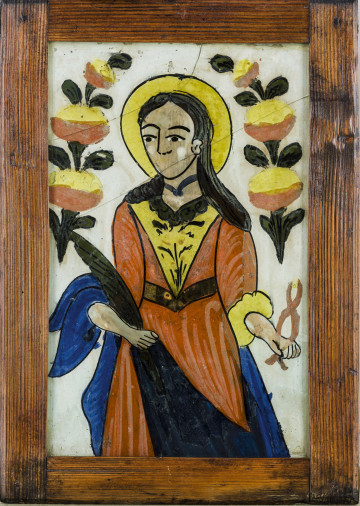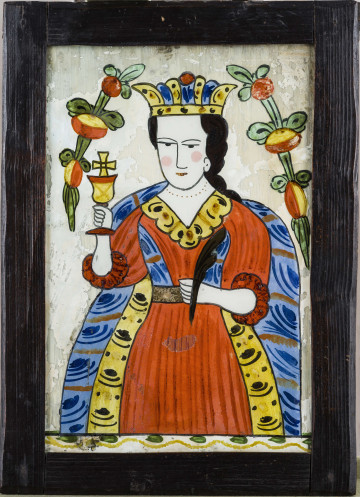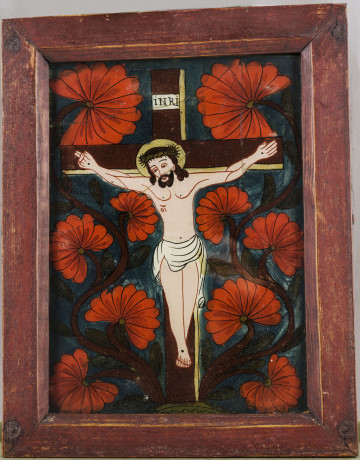
Saint Apolonia
1801 — 1900
National Museum in Lublin
Part of the collection: Folk Art of the Lublin Region (17th–1st half of the 20th c.)
Michelangelo's 15th-century Vatican Pieta is the most common depiction of Mary in sorrow with Jesus folded in her lap. It has been known since the 14th century, as has the image of a weary Mary adoring the body of her Son hanging on the cross, and Mary with a sword piercing her breast or heart. In the image of Our Lady of Sorrows, the number of sharp swords increased over time to seven and were attributed with the symbolism of the seven sorrows, namely: the prophecy of Simeon, the flight into Egypt, the loss of the twelve-year-old Jesus, the encounter on the Way of the Cross, the crucifixion and death of Jesus, the removal from the cross and the laying in the tomb. Interestingly, Mary in these depictions was often shown as a young woman, even though she was about fifty years old at the time of Christ's death.
Glass paintings were usually purchased at feasts or from itinerant dealers – imaghe makers. They were hung above the table in the "holy corner" or at the ceiling, resting on a slat, often richly decorated with engravings, running across the entire width of the most important wall, usually opposite the entrance. They reflected the flames from the hearth of the cooker or the light of an oil lamp, which illuminated the interior. It created a peculiar pantheon of biblical and holy figures looking down on the peasant family as if from heaven. The most important documents were also entrusted to the protection of the saints in the paintings - land grant deeds, wills, etc. were hidden behind the paintings or under their frames.
From around the mid 19th century, when the mass production of lithographs and oleo-prints began, the production of glass paintings lost its raison d'être and ceased to reach the countryside. Older people, however, did not want to be convinced by "paper" paintings. They claimed that hanging them in the rooms, they quickly became damaged as they wrinkled under the influence of moisture and developed stains. They also became illegible as a result of a layer of greasy dirt settling on them. Glass paintings were much more praised, as after wiping them with a cloth they regained their colour and gained brilliance. Paper reproductions in peasants' cottages were accepted with time. Subsequent generations liked the vivid colours and the attention to detail and character of the painted figures. Such images were also accepted by the Church and recommended as consistent with the current iconography.
Author / creator
Dimensions
cały obiekt: height: 20,5 cm, width: 31 cm
Object type
picture
Material
glass, oil-based paint
Creation time / dating
Creation / finding place
Owner
The National Museum in Lublin
Identification number
Location / status

1801 — 1900
National Museum in Lublin

1801 — 1900
National Museum in Lublin

1801 — 1900
National Museum in Lublin
DISCOVER this TOPIC
National Museum in Szczecin
DISCOVER this PATH
Educational path